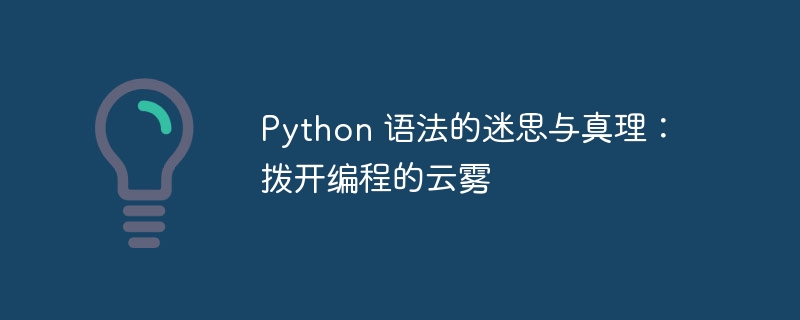Home >Backend Development >Python Tutorial >Myths and truths about Python syntax: clearing the fog of programming
Myths and truths about Python syntax: clearing the fog of programming
- WBOYWBOYWBOYWBOYWBOYWBOYWBOYWBOYWBOYWBOYWBOYWBOYWBforward
- 2024-02-20 21:42:02955browse

Myth 1: Indentation is not important
Truth: Indentation is crucial in python. Unlike other languages that use braces or semicolons to separate blocks of code, Python relies on indentation to define the scope of statements. Incorrect indentation can lead to syntax errors or unexpected behavior.
Demo code:
# 正确缩进
if condition:
print("条件为真")
# 错误缩进
if condition:
print("条件为真")# 缩进错误
Myth 2: Semicolons are optional
Truth: In Python, a semicolon at the end of a statement is usually unnecessary. However, in some cases, using semicolons can improve code readability or avoid syntactic ambiguity.
Demo code:
# 可选的分号
print("无需分号")
# 提高可读性的分号
if condition: print("条件为真")# 分号提高可读性
Myth 3: Single quotes and double quotes are the same
Truth: Single quotes and double quotes are not the same in Python. Single quotes represent string literals, while double quotes allow string interpolation, i.e. dynamically embedding variables or expressions into a string.
Demo code:
# 单引号字符串文字
name = "John"
# 双引号字符串插值
message = f"欢迎 {name} 加入团队。"# 使用 f 字符串进行插值
Myth 4: Operator precedence is fixed
Truth: While Python does follow the rules for operator precedence, it allows precedence to be modified through parentheses. Expressions in parentheses will be evaluated first.
Demo code:
# 标准优先级 result = 2 + 3 * 4# 乘法优先于加法,结果为 14 # 使用括号覆盖优先级 result = (2 + 3) * 4# 加法优先于乘法,结果为 20
Myth 5: All variables are dynamically typed
Truth: While Python is best known for its dynamic type system, it also supports explicit type annotations. Type annotations can help improve code readability, maintainability, and performance.
Demo code:
# 动态类型变量
x = 5
# 类型注释
def my_function(name: str) -> int:
"""返回一个以参数 name 为名的问候消息."""
return f"你好,{name}!"
in conclusion
By debunking these common Python syntax myths, programmers can gain a deeper understanding of the language. Understanding the importance of indentation, the nuances of semicolons, the difference between single and double quotes, the flexibility of operator precedence, and the benefits of explicit type annotations will enable them to write cleaner, more robust, and more maintainable code.
The above is the detailed content of Myths and truths about Python syntax: clearing the fog of programming. For more information, please follow other related articles on the PHP Chinese website!

